Episodes
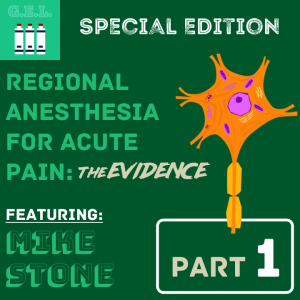
Monday Dec 09, 2019
US-Guided Regional Anesthesia for Acute Pain: The Evidence
Monday Dec 09, 2019
Monday Dec 09, 2019
Everyone who has ever done one knows that ultrasound guided blocks are great. They seem to help patients, they are fun to do, but are they supported by the evidence? Mike Stone joins in on this two part, special edition dive into the studies out there for performing ultrasound guided regional anesthesia for acute pain. https://www.ultrasoundgel.org/82
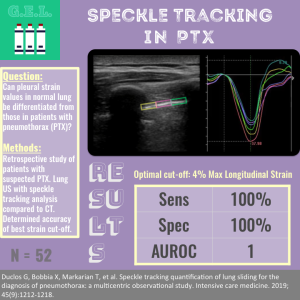
Monday Nov 25, 2019
Speckle Tracking in Pneumothorax
Monday Nov 25, 2019
Monday Nov 25, 2019
Speckle tracking is a relatively new ultrasound technology that lets you graph the movement of tissue over time. We know this can be useful to look at cardiac function, but no one dared to try it out on the lung...until now! The idea here is that by using speckle tracking on the pleural line, there might be a higher accuracy in detecting pneumothorax on ultrasound! It sounds crazy...but maybe it's just crazy enough to work. https://www.ultrasoundgel.org/81 https://www.ncbi.nlm.nih.gov/pubmed/31359081
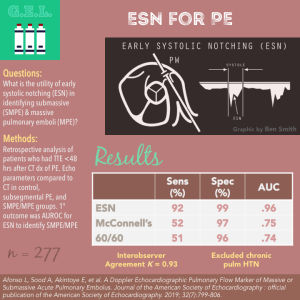
Monday Nov 11, 2019
Early Systolic Notching for Pulmonary Embolism
Monday Nov 11, 2019
Monday Nov 11, 2019
A focused echo can go a long way in a patient with a suspected pulmonary embolus (PE). It can be especially valuable in those that are so sick and unstable that you need answers right away. In this way, point-of-care echo has been shown to help to diagnose submassive and massive pulmonary emboli by identifying signs of right heart strain. Echo parameters such as right ventricle diameter and right ventricular function (such as in TAPSE) are often part of the evaluation, but these are not as accurate as we would like. These authors propose a new doppler marker of a submassive or massive PE- enter the Early Systolic Notching pattern. https://www.ncbi.nlm.nih.gov/pubmed/31056367
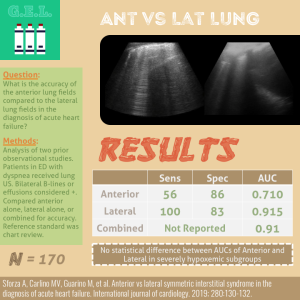
Monday Oct 28, 2019
Anterior vs Lateral Lung Fields in Heart Failure
Monday Oct 28, 2019
Monday Oct 28, 2019
Suspected acute heart failure is a great reason to use point-of-care ultrasound. It can tell you in seconds if this patient is up to their neck in pulmonary edema. Knowing that interstitial edema is more common in dependent areas of the lung, one would think that the lateral areas of the lung fields would be most sensitive for the diagnosis. Likewise, if there is enough pulmonary edema to fill up the anterior lung fields, this theoretically should be pretty specific. But is this actually true?! These authors investigate the issue. https://www.ncbi.nlm.nih.gov/pubmed/30665807

Tuesday Oct 15, 2019
Small Bowel Obstruction (#2)
Tuesday Oct 15, 2019
Tuesday Oct 15, 2019
POCUS can be used to visualize small bowel obstruction (SBO) fairly easily. It has proven itself superior to xrays and has some advantages over CT, which for most people is the standard for diagnosis. Although initial work was quite promising, there were no large studies done confirming the accuracy of ultrasound for this purpose. In this podcast we examine the latest study (plus discuss a bonus similar one) that reveals maybe this is not as good as we thought! https://www.ncbi.nlm.nih.gov/pubmed/30762916

Monday Sep 30, 2019
LVOT Opening in Cardiac Arrest
Monday Sep 30, 2019
Monday Sep 30, 2019
There are many ways that TEE can help you in cardiac arrest. One of these is to monitor your chest compressions to make sure they are actually doing what you want. Although this makes sense intuitively and is supported by animal models, there has not been a lot of evidence to date. This article takes a step in that direction by showing some data on outcomes in humans. https://www.ncbi.nlm.nih.gov/pubmed/30825552
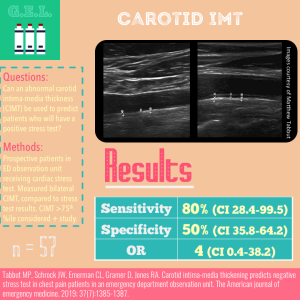
Monday Sep 02, 2019
Carotid Intima-Media Thickening
Monday Sep 02, 2019
Monday Sep 02, 2019
We know that the carotid arteries are easily seen on ultrasound, but usually we think of this scan in the context of comprehensive sonography. Certainly, it is not hard to believe that having increased atherosclerotic build up would put someone at increased risk for coronary artery disease, but what can we do with that in the acute setting? These authors had an idea - maybe measuring the Carotid Intima-Media Thickness (CIMT), could be a predictor of the outcomes of a cardiac stress test. Is this brilliance or craziness? Decide for yourself! https://www.ncbi.nlm.nih.gov/pubmed/30612781/
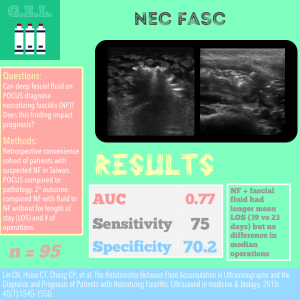
Monday Aug 19, 2019
Necrotizing Fasciitis
Monday Aug 19, 2019
Monday Aug 19, 2019
Necrotizing fasciitis (NF) is a real bad deal. We usually rely on clinical exam (which can be misleading) or other imaging studies (which can take forever) to make the diagnosis. POCUS would be an awesome solution in helping to make this time-sensitive determination. We know it can pick up fascial fluid, air, subcutaneous changes...but really how good is it when it comes down to diagnosing this deadly disease? https://www.ncbi.nlm.nih.gov/pubmed/31031033
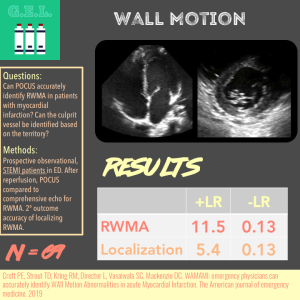
Monday Aug 05, 2019
WAMAMI! Wall Motion Abnormalities in Acute Myocardial Infarction
Monday Aug 05, 2019
Monday Aug 05, 2019
Theoretically, regional wall motion abnormalities (RWMA) would be really useful in the acute care setting. In the patient with concern for cardiac ischemia, this finding might help push to definitive management. The problem is that this is a nuanced exam - it takes some experience and practice. It hasn't been studied much in the point-of-care world. So can emergency physicians with relatively little training do this accurately? Find out in this next adventure into the world of point-of-care echocardiography! https://www.ncbi.nlm.nih.gov/pubmed/30987914
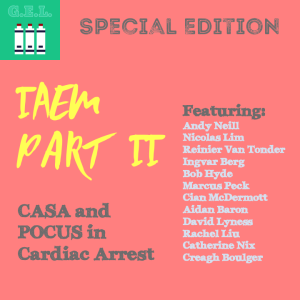
Monday Jul 22, 2019
CASA and POCUS in Cardiac Arrest
Monday Jul 22, 2019
Monday Jul 22, 2019
In part 2 (and the finale) of the series from the IAEM conference, the discussion heats up even more! The same star-studded international band of wisdom and wizardry tackles POCUS in cardiac arrest. They discuss the CASA exam and other pointers for using POCUS in the pulseless patient. A must listen!

